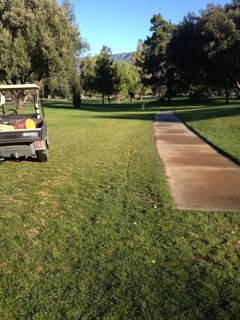The success and failure of the agronomic plan we implement at Arrowhead Country Club will always be linked to the dominance and percentage of bentgrass in our greens. Greenway Golf's surface management philosophy has been critically scrutinized over the years due mainly to the lack of understanding revolving around the "non-industry standard" practices. The approach considered by many as unique and secretive is not only successful, but environmentally conscious. There are many factors that influence the success of this program, but I would like to address one of them in this posting: Mowing Frequency.
We utilize daily, monthly, and annual task tracking to measure opportunities for reduction and calculate efficiencies on each specific property. One commonality across the properties that are managed by Greenway Golf is the limited amount of greens mowing. In 2011 on a weekly average, we cut the greens 2.67 days out of seven at Arrowhead Country Club. To put it in perspective, most courses are mowing six to seven days a week with supplemental double cutting.
There happens to be a direct correlation to Bentgrass competitiveness and population and frequency of cut. Seasonal variation and a Superintendent's management practices should influence the decision to mow or not and understanding the strengths and weakness of Bentgrass is key. With sustainability and minimalism being hot button topics within the industry these days, it only makes sense to limit practices that negatively impact Bentgrass competitiveness.
Stump Grinding Completed
This Monday the final reminder of the major windstorm that blew through the course this past November was addressed. Tree Pros Inc. was on site to mechanically grind the tree stumps left behind by the damage inflicted by the powerful winds and subsequent chainsaw activity. Over the next few days the staff will remove the mulch/soil mixture, fill the void with clean soil, compact the material, and sod the impacted areas.
Tree stump removal is essential in providing for the safety of golfers, guests, and employees. Tree stumps present tripping hazards for individuals walking the course and pose potential mechanical hazards/expensive repairs to mowing equipment and golf carts traversing in their proximity.
Tree stump removal is essential in providing for the safety of golfers, guests, and employees. Tree stumps present tripping hazards for individuals walking the course and pose potential mechanical hazards/expensive repairs to mowing equipment and golf carts traversing in their proximity.
Evaluating Reel Motor Speed
We have been experiencing an inconstancy issue with the quality of cut of the intermediate and surround mower. The outer left unit is not producing the level of quality cut that we expect and leaving a plateau appearance on the turf. In the troubleshooting process we verified reel to bed knife relief, height of cut, bearing movement, and reel to ground speed ratio. Next on the list was to verify individual reel speed and hydraulic motor efficiency. To measure this a digital infrared tachometer is utilized. (Pictured below) We discovered that the suspect unit was underperforming and will require further diagnostics.
Stump Removal
We continue to work on the final stages of the clean-up from the December wind events. The remaining tree stumps are scheduled to be ground the final week of February.
More Irrigation Amendments
We have spent several days in the past two months modifying irrigation station "wiring". With the age of the system and subsequent old school philosophy of wiring techniques during that time, alterations and modifications can be a bit more time consuming than anticipated. The 1978 design specified many of the stations to consist of multiples of "paired" sprinkler heads. "Daisy chaining" as it is referred to by many is the connection of multiple sprinkler heads on one zone wire. To conserve on wire, the installation of these "chains" seldom followed the lateral pipe buried in the ground. The lack of splice boxes at the lateral lines and poor as-builts make tracing these wire paths a chore.
Over the past several years we have worked diligently to split or break the large chains of heads down to a manageable number for the hydraulics and programing of the central control system. This has improved our pressure at the sprinkler heads and reduced the "donuts" of dry turf in close proximity of the head that many members have shared "fond" stories of. We are down to addressing our final two zones operating (6) sprinkler heads a piece. Not only will I be happy, but the pump station flow ramp will appreciate the completion of this exercise as well.
Over the past several years we have worked diligently to split or break the large chains of heads down to a manageable number for the hydraulics and programing of the central control system. This has improved our pressure at the sprinkler heads and reduced the "donuts" of dry turf in close proximity of the head that many members have shared "fond" stories of. We are down to addressing our final two zones operating (6) sprinkler heads a piece. Not only will I be happy, but the pump station flow ramp will appreciate the completion of this exercise as well.
Quick Cart Path Edging
One task included in our detail management philosophy is the the mechanical edging of the cart paths. Based on growth and presentation, this project is on average completely monthly. It requires 18-19 man hours of labor, two mechanical edgers, a pair of flat shovels, and a forced air blower mechanism. The result is a crisp, clean appearance and nice contrast to the adjacent turfgrass.
 |
| #8 Cart path post edging and prior to debris clean up |
Subscribe to:
Comments (Atom)










